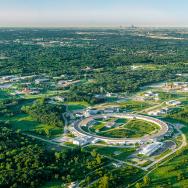Leaders from the U.S. Department of Energy, Argonne National Laboratory and the University of Chicago broke ground July 22 on the future of X-ray science in the U.S.
The small gathering marked the start of construction on an $815 million upgrade of the Advanced Photon Source, one of the most productive light sources in the world.
The site will soon become the Long Beamline Building, a new experiment hall that will house two new beamlines—which will transport the ultra-bright X-rays generated by the Advanced Photon Source to advanced scientific instruments.
Located at UChicago-affiliated Argonne National Laboratory, the Advanced Photon Source is in essence a stadium-sized X-ray microscope. It attracts more than 5,000 scientists from around the globe to conduct research each year in fields ranging from chemistry to life sciences to materials science to geology.
“The upgrade of the APS is not only an exciting scientific project, but it is vital to ensuring that Argonne and the United States remain world leaders in X-ray science,” said DOE Under Secretary for Science Paul Dabbar, who attended the socially-distanced ceremony. “An upgraded APS, including these two longer beamlines, will lead to new innovations in energy efficiency, more durable materials and more tools to combat viral pandemics.”
The APS Upgrade will replace the already powerful electron storage ring at the heart of the facility with a state-of-the-art magnet lattice system that will increase the brightness of the generated X-rays by up to 500 times. As part of this project, nine new beamlines will be constructed around the existing storage ring to facilitate a variety of research aims; the Long Beamline Building will host two of them.
“The APS Upgrade is a cornerstone of Argonne’s future,” said Argonne Director Paul Kearns. “In conjunction with other unique resources such as Argonne’s supercomputers, the new beamlines at the upgraded APS will allow the pursuit of science at a scale previously thought impossible, enabling greater impact from breakthroughs in healthcare, manufacturing, national security, transportation and energy.”
As the name implies, the beamlines housed in the Long Beamline Building will be about three times longer than those currently at the APS, sending photons further from the source to reach the samples being analyzed. This distance allows for more focused X-ray beams, allowing scientists to look at something as small as the finest structure inside even the most compact computer chip, in real time.
“The University of Chicago is proud of its long association with Argonne and the APS,” said Juan de Pablo, the Liew Family Professor in Molecular Engineering and Vice President for National Laboratories at UChicago, who attended the ceremony. “We look forward to many more years of vital, world-changing research at the upgraded facility.”
The new facilities will also have greater capability for in situ imaging, meaning observing samples as scientists change the environment around them. This will allow for precise measurement of the impact of temperature, pressure and other factors on advanced materials, an important step toward creating the next generation of components for everything from aircraft engines to solar cells.
One of the two new facilities in the Long Beamline Building will be the In Situ Nanoprobe, whose beam will be able to focus down to just 20 nanometers. One application would be more precise understanding of electrochemical reactions inside batteries, which is anticipated to lead to breakthroughs in extending battery life.
The other is the High-Energy X-Ray Microscope, designed for higher-energy X-rays that can penetrate into denser materials with greater focusing ability. This will allow scientists to more precisely map the compositions of materials. Its ability for in situ measurements will make it a destination beamline for materials science and engineering applications; for example, one application would be to test airplane engine blades under stress, to see where cracks form in the materials they are made of and learn how to prevent them.
“Our goal is to create the most advanced and comprehensive facility we can for the scientists from across the United States and around the world who use the APS,” said Robert Hettel, project director for the APS Upgrade. “These improvements will be a game changer for the facility, and for X-ray science as a whole.”
Construction is scheduled to begin this fall, with a proposed completion date in mid-2022 for the Long Beamline Building. First light for the APS Upgrade is expected in late 2023.
“The APS Upgrade will be transformational,” said Stephen Streiffer, Argonne’s deputy director for science and technology and director of the APS. “For users of the APS, it will be like the difference between walking and flying a jet airplane. It will revolutionize our ability to explore the boundaries and horizons of science, and the Long Beamline Building will allow us to take full advantage of the upgrade’s capabilities.”
More information on the APS Upgrade is available here.
—Adapted from an article posted by Argonne National Laboratory by Andre Salles.

